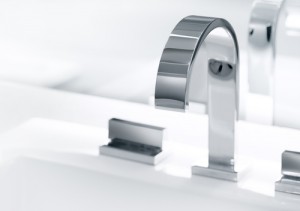 Hard water, while not a health risk, presents a number of concerns to homeowners as it causes mineral buildup on pipes, plumbing fixtures and heating systems over time. If your home is affected by limescale, regular cleaning and preventative maintenance will be required both for aesthetics and to protect your plumbing systems.
Hard water, while not a health risk, presents a number of concerns to homeowners as it causes mineral buildup on pipes, plumbing fixtures and heating systems over time. If your home is affected by limescale, regular cleaning and preventative maintenance will be required both for aesthetics and to protect your plumbing systems.
Diligence & Regularity
The key to keeping tabs on limescale in your home is to not let calcium deposits get out of control in the first place. Thicker limescale deposits become exponentially more difficult to remove. Cleaning fixtures as soon as water stains start to appear will require a lot less elbow grease.
Commercial vs. All-Natural Products
Another advantage to nipping your limescale problem in the bud early is the ability to use all-natural solutions instead of harsh chemicals.
For lighter stains, a solution of white vinegar and water or lemon juice will dissolve and remove deposits. The longer you leave the cleaning agents to soak the better the results.
Hot Water Heater Maintenance
Given that heat is a contributing factor to limescale buildup, the elements of your hot water heater are particularly susceptible to calcium and magnesium deposits. Elements coated in these minerals perform poorly, are inefficient and eventually fail. When left untreated for too long, deposits in your tank will cause rattling and banging.
Routinely flushing your water tank is an important preventative measure to remove mineral particles before they can adhere to vital parts:
- Shut off the electricity or close the gas line.
- Wait for the water to cool. (Run a load of laundry, take a shower or wash the dishes to speed up the process.)
- Close the cold-water intake valve.
- Connect a hose to the drain valve and empty the tank safely outside your home.
- Once empty, remove the hose, close the drain and open the intake valve to refill the tank.
- Turn the electricity or gas back on. Reignite pilot light if required.
At a bare minimum, your tank should be flushed twice per year. Repeat more often in areas where water is especially hard. Remove electrodes and soak them in white vinegar 4–6 hours to prolong the life of your water heater.
Cleaning Household Appliances
Most appliances can be cleaned by simply running vinegar or lemon juice through the system.
- For dishwashers and washing machines, simply pour a concentrated solution in where the detergent usually goes and run as normal.
- For electric kettles and coffee makers, heat the solution and allow it to soak overnight.
Kitchen & Bath
Soaking rags in vinegar and wrapping them around taps and faucets is a great way to remove limescale. To clean screens or showerheads, tie a plastic bag filled with cleaning solution around the end of the fixture and allow it to soak overnight.
For toilets, sinks and tubs, you may need a commercial grade product to fully remove stains. In severe cases, a pumice stone will help remove thick deposits.
A Full-Scale Solution
Investing in a water-softening system is perhaps the most reliable method for controlling limescale throughout your entire home. A water softener works by exchanging “hard” ions of calcium and magnesium with softer ions, usually sodium.
Over time the system will run out of sodium ions, however, and need replacement.
While maintaining a water-softening system certainly carries a cost, the cost-benefit analysis usually shows long-term gains in a lack of damage to pipes, plumbing fixtures and household appliances.
As an added bonus, soaps and detergents are more effective when applied with soft water. Following the installation of a water softener, homeowners report cleaner dishes, cleaner clothes and a more pleasant bathing experience.
